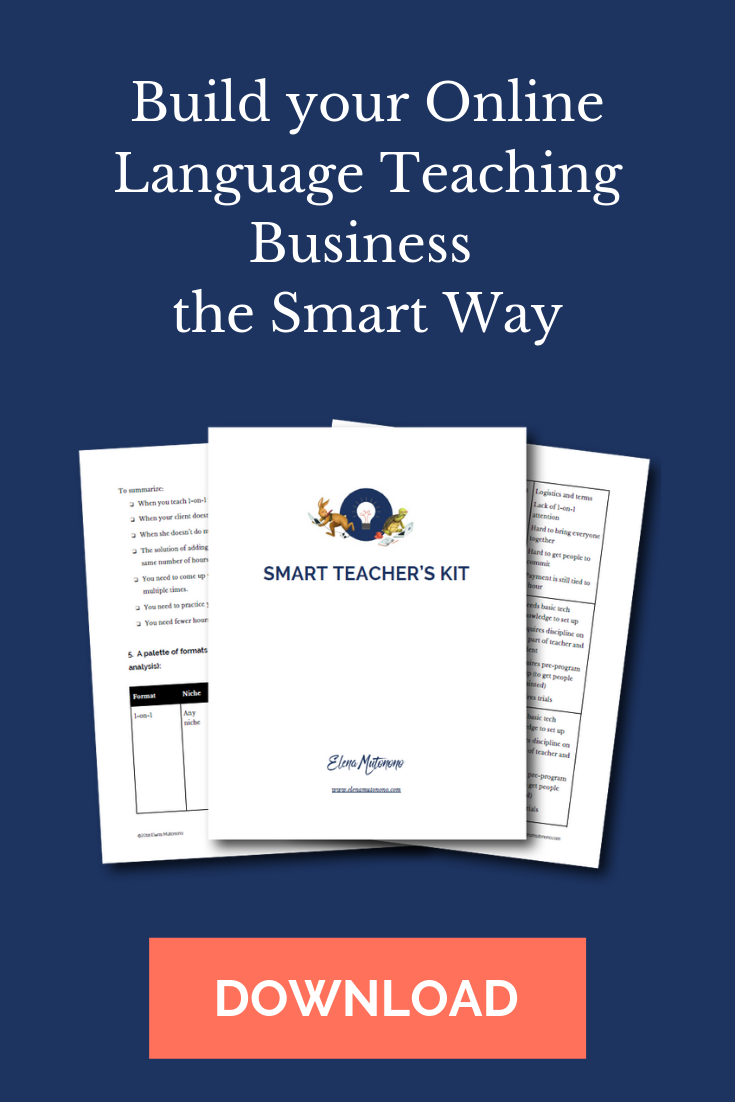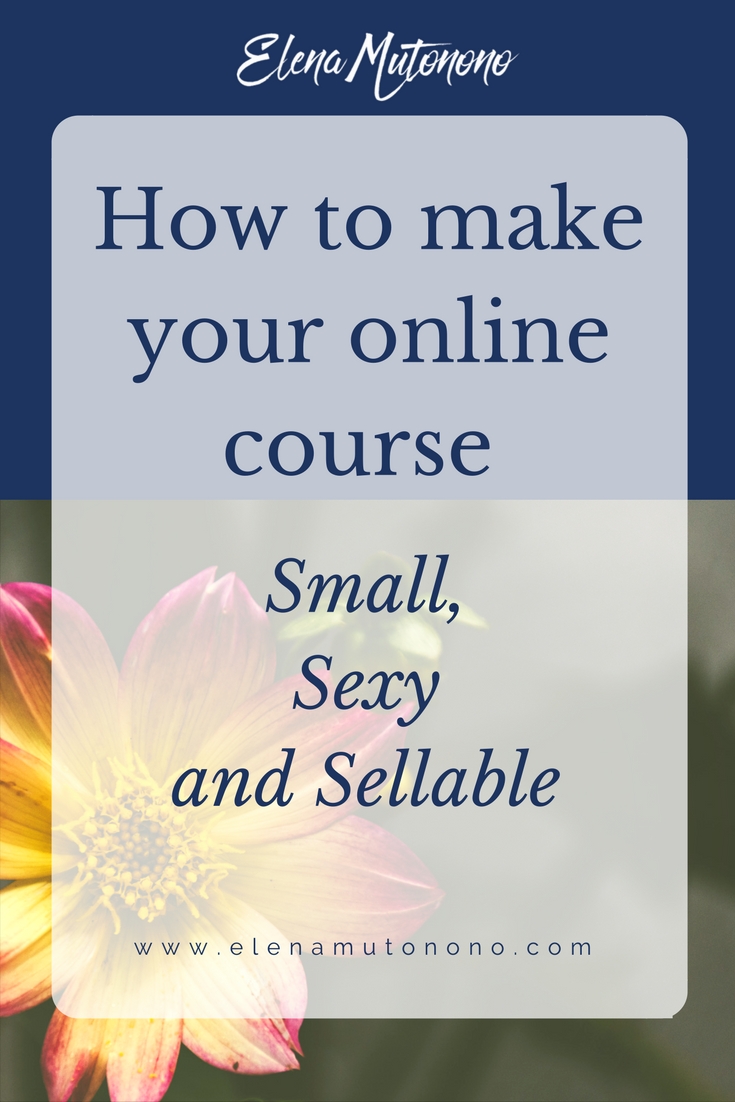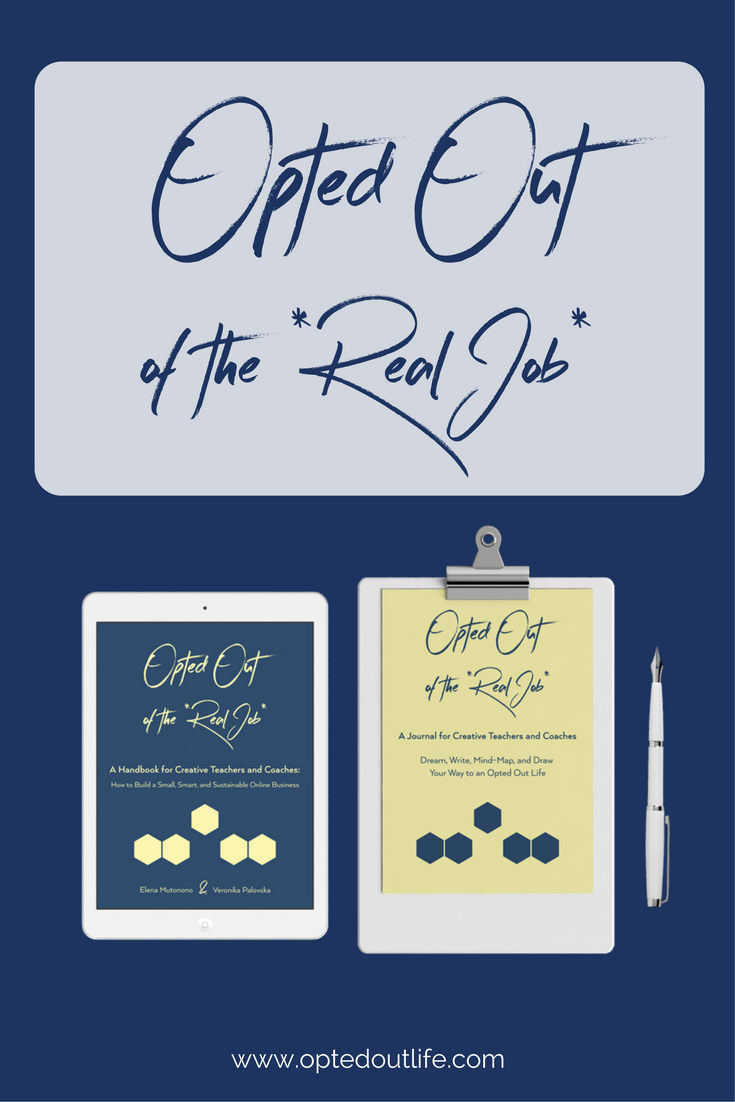You may have heard this many times: self-publish a book so you can teach with more authority and find ideal clients. But where do you start? Where’s the guarantee that a tiny book will bring ideal clients your way? And – what if you’re not a writer?
I self-published my first book in 2016, and everything you see on this website today: other books, workshops, mini-courses, the Online Teacher Summit and my Smart Teacher’s Library – are all the result of that one book!
That tiny self-published e-book attracted my ideal clients even though I wrote it in my non-native English and initially used fiverr to design the cover.
Many coaches and teachers self-publish books, but not many books generate clients. In this post I want to explore:
- How to write a book that attracts your ideal clients.
- How to self-publish a book when you don’t feel like a writer.
How to write a book that attracts your ideal clients.
Most online language teachers don’t start out with large online communities, so it is unrealistic to hope that your book will be your money maker in the beginning. But if you self-publish it with your ideal client in mind, it will begin bringing ideal clients your way – people who won’t complain about your price and will be excited about your work.
For a number of self-employed online language teachers and coaches, the initial goal for self-publishing a book is to attract ideal clients. To achieve it, here are three things you need to bring into alignment in your publishing process:
- Your ideal client.
- Your niche (or the focus of your work).
- The theme of your book.
If the concept of niching sounds murky, check out this post.
Let’s look at image 1 and see if a book 50 Phrasal Verbs you Need to Know will attract the teacher’s ideal clients.
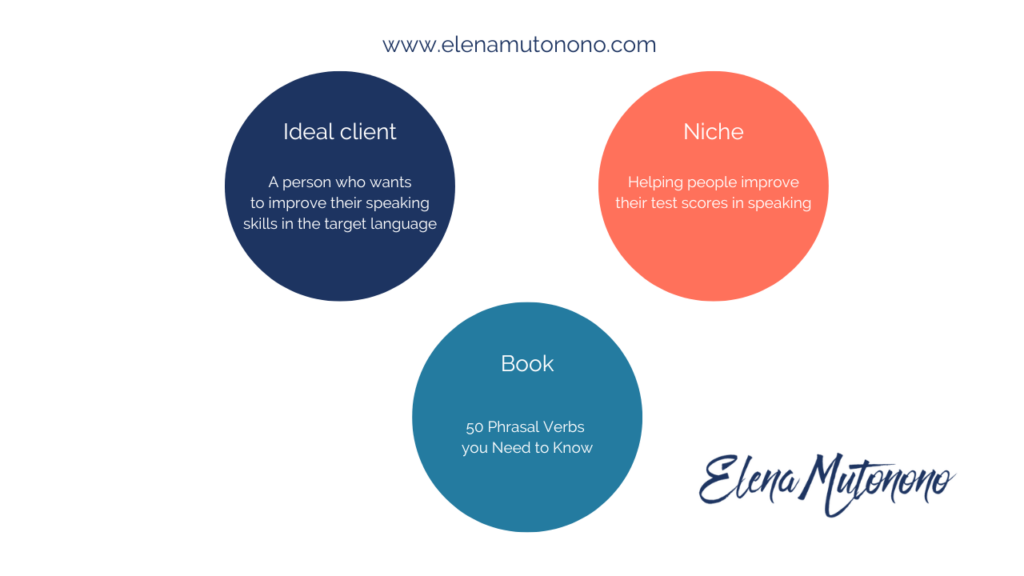
From the image we see that this teacher’s ideal client is someone who needs help with speaking skills. The actual niche is narrower – the teacher helps improve speaking skills for people who take tests. It is possible that while their niche is defined really narrowly, this teacher still wants to invite everyone who needs to improve their speaking skills.
To generate more clients, the teacher self-publishes a book called 50 Phrasal Verbs you Need to Know but the book doesn’t accomplish its main goal. It happened because the 3 components (ideal client, niche and theme of the book) were not aligned.
This alignment of niche – ideal client – a book (or any product/service) is challenging because it requires that we leave behind the wishy-washy-I-can-teach-anyone mindset and focus on one thing. The fear of losing some “potential might-be clients” and saying no to some, prompts us to do anything we can to attract crowds, which doesn’t result in more sales.
Here’s a more in-depth look on how to make sales more effective.
I’ve known teachers and successful content creators (bloggers and podcasters with thousands of readers or listeners) who struggled to sell one $25-lesson, and all because of such a misalignment:
- The niche is generic.
- The ideal client is not defined.
- The book is off-topic.
While seeking alignment is a constant process on our business journey, let’s connect all 3 components from image 1 in a coherent way:
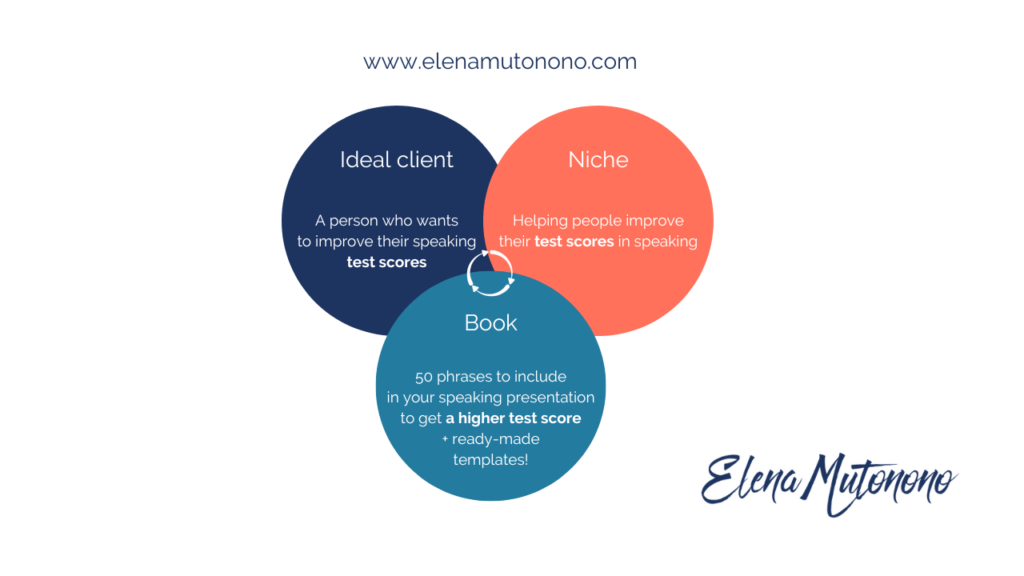
Now the ideal client for this teacher is someone who wants to improve their speaking scores for a test. If that’s the niche, then this is the ideal client.
It doesn’t mean you will (never) work with anyone else. What that means is everywhere on your site and on social media you write for people who want to improve their speaking scores in their tests, not those who just need a bit of speaking practice.
Then, to attract such clients, instead of writing a book on Phrasal verbs that everyone needs to know, this teacher can self-publish a book on phrases to include in the speaking part of the test to increase test scores.
To make the book more attractive to this teacher’s ideal client (and to sell their expertise, too), it helps to add templates or samples.
Check this post for more ideas on how to make your product more sellable.
Now that we’ve clarified and aligned these 3 components, let’s move on to the idea of self-publishing “even if” you’re not a writer.
How to self-publish a book when you don’t feel like a writer (with examples!)
In her newsletter titled 25 reasons to write a book, best selling author Alexandra Franzen wrote that you should write a book because “you’ve already written 10 books worth of email this year, so why not write an actual book?”
By the way, sign up for Alexandra Franzen’s newsletter, you won’t regret it!
If you’re teaching and building your own business online, you are already doing a lot of writing: sales pages, lead magnets, social media posts, emails or newsletters, scripts for your videos or podcasts…
In the beginning of your journey your writing may be minimal, but once you make that shift, there will be no escape from writing. So why not take what you write anyway and turn it into a book?
I’m going to share a few simple ideas with you.
#1: Convert your blog post(s) into a book.
I started this blog in November 2014 with the audience of zero. I wrote long blog posts and shared them in LinkedIn groups which was the trend at the time. Teachers from groups would come to my blog and sign up for my newsletter.
In case you’re not signed up yet, here’s the link!
2 blog posts a month = 20 blog posts a year (about 30,000 words). At the end of the year I chose 10 most popular ones, formatted and edited them for a book and sold it on Gumroad. A year later I rewrote this book with Veronika Palovska and put it on Amazon. You might be here today thanks to that book!
#2: Convert your social media posts into a book.
If your social media posts are geared towards your ideal client, you can organize them into a book as well. Develop some posts into longer chapters, as Maria Glazunova did, or leave them as they are and turn them into a small book with tips and/or inspiration.
You may ask yourself, “why would anyone pay for something they can find online for free?” Here’s where the mindset shift comes in. Nobody is going to go through your entire blog or social media and remember everything. It’s too clumsy and difficult to save.
Self-publishing all your work as a book is your way of simplifying learning for your potential clients, and that’s worth their $5, $10 or even $30!
'When you teach online your self-published book is a tangible representation of your work.' ~ Elena MutononoClick To Tweet
#3: Turn your podcast scripts into a book.
Linda Riolo from PiccoloMondoItaliano turned her podcast scripts into collections of resources for learners of Italian. She put them together into a PDF format and added a beautiful design in her branding colors.
Today a portion of her revenue comes from her script sales, and her listeners and customers have now become members of her community, signing up for programs and courses that all revolve around her podcast.
Another great example of turning a podcast into a book is Rhea Pechter’s Little Stories for Tiny People project. My kids love her podcast, and I bought her amazing book to support her work.
You can also create an audio book (aka an audio course), the way Chiara Coombs did. Such a resource helps Chiara’s clients improve their listening skills and prepares them to work with her 1:1.
#4: Turn your newsletters into a book.
This one requires a bit of planning, but if you choose to create a 5-10-email sequence on a specific subject that may benefit your clients, you can later convert it into a book. It can become your free product (aka lead magnet) or you can sell it.
Another option (especially if you struggle with what to write in your newsletter) is to write 1 chapter a month and send it for your subscribers to read. 1 year later you will have a book ready for publishing. Dominique Cordero started writing her book last year this way, and now she’s almost done.
#5: Write down your stories.
You might be one of those people with stories running through their head all day. How fun is it to write them down so you can use them with your own clients? No more reliance on textbooks (which many teachers dislike anyway) – create something of your own and release it into the world.
Irina Skibenko has done that when she self-published her Nina and Eve series for pre-teens and teens who love reading in English.
Anna LoMastro has published her Grammar books as interactive stories, and Andre Klein’s series for German learners Dino lernt Deutsch is a bundle of books that will get you hooked from beginner level.
Note: in my chats with online language teachers in our community I always hear this question: how can I teach kids, pre-teens or teens? While companies like VIPKid provide you with all the resources, it’s hard to know how to do it on your own. I always encourage teachers to write their own stories as a way to attract parents and their children.
When’s the best time to self-publish a book?
If you want your dream clients to find you a year from now, start working on your book today. A year gives you enough time to get to know your audience, to write for them, to engage with them and to release a product they will value and recommend to others.
When I ask online language teachers in our community how their work is different, they talk a lot about their experience and expertise and sometimes show their certificates.
But when you work online, your experience and expertise, even after you scan your diplomas, is largely invisible, but a book (or any other product you create) is a tangible representation of your work.
A book also opens doors and creates collaboration opportunities you cannot imagine.
Books are a great way to work smarter. If someone wants to work with you but can’t afford it – let them read your book. They may like it and then continue working with you. Or they may realize your angle isn’t for them (in which case they haven’t lost a lot of time and money!)
Finally, self-publishing a book is a way to charge more competitive prices for your services.
Featured: How to stop charging by the hour and begin working smarter.
If you want to write a book this summer and need some guidance and feedback, our community is here to give you ideas and support, starting from what to write, how to write, where to edit and self-publish without spending thousands of dollars.
Join our Summer in the Library experience and give yourself a 3-month deadline to write the draft of your first book.

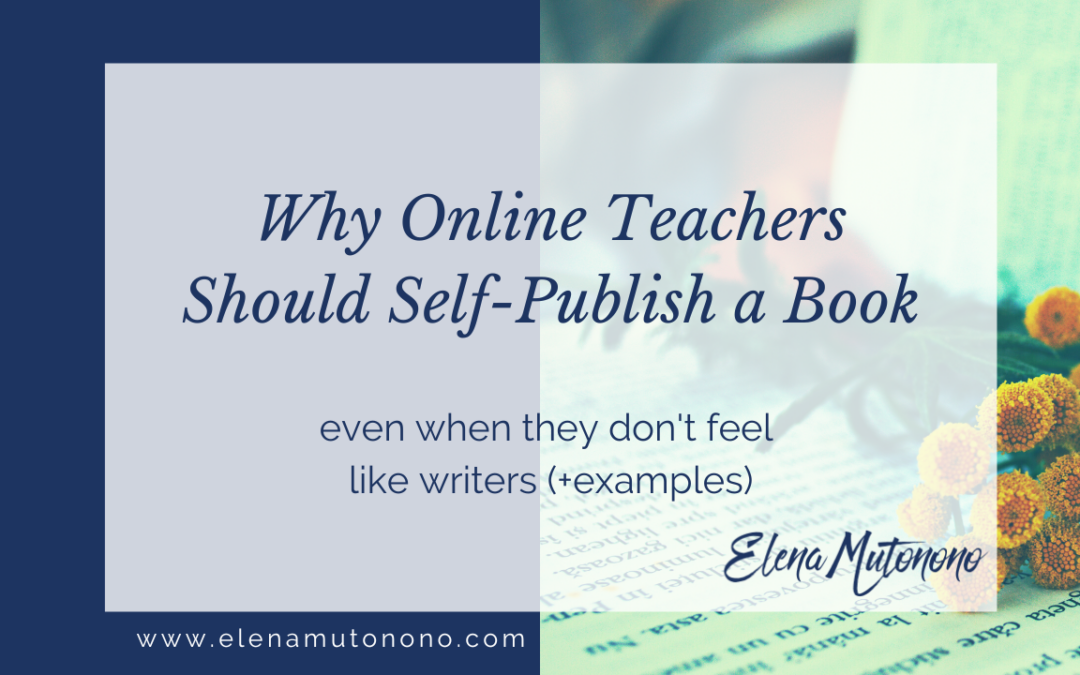
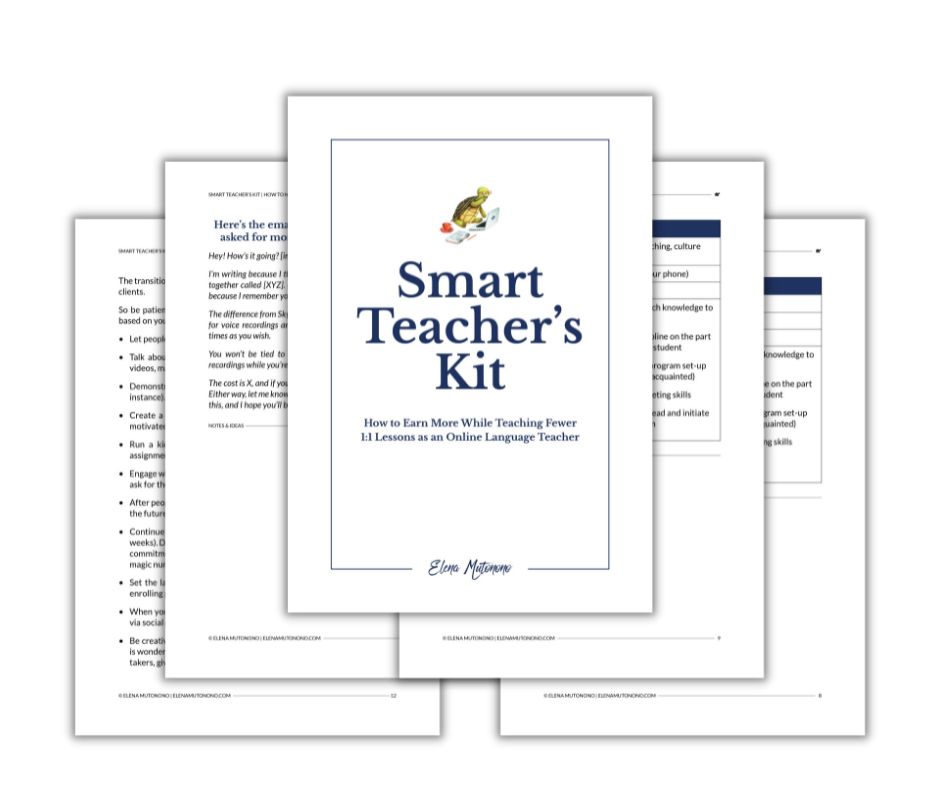
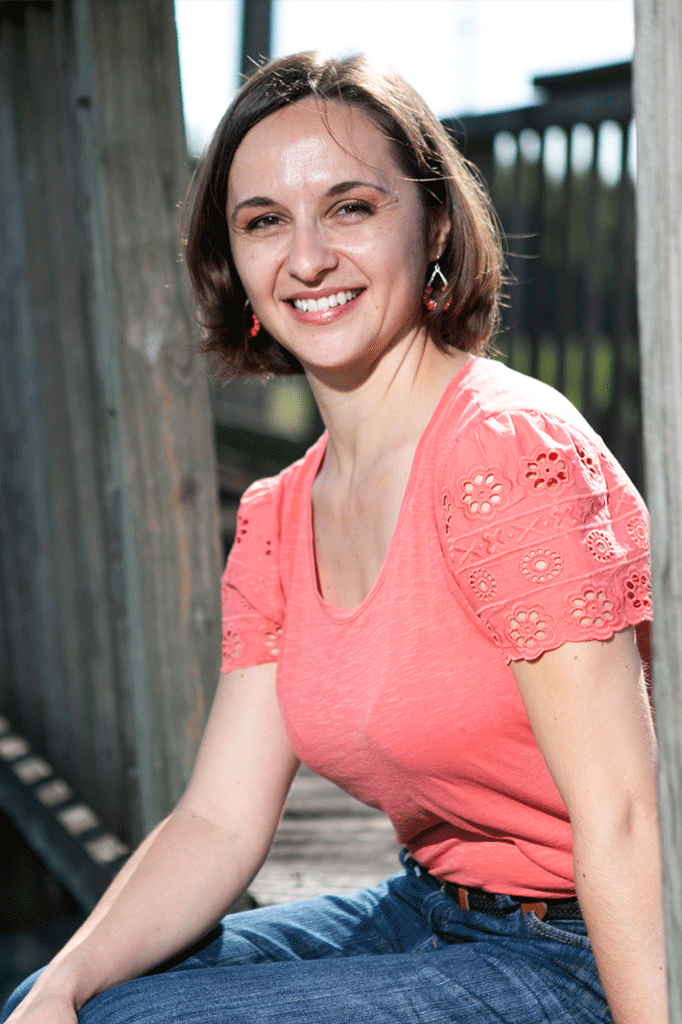 Welcome to my nook where *Big Magic* happens. My name is Elena Mutonono, I help small business owners package their services as digital products and sell them online. I want you to work smarter, not harder. Increase your impact beyond your current face-to-face clients. Grow your business as you reach more people all over the world.
Welcome to my nook where *Big Magic* happens. My name is Elena Mutonono, I help small business owners package their services as digital products and sell them online. I want you to work smarter, not harder. Increase your impact beyond your current face-to-face clients. Grow your business as you reach more people all over the world.
